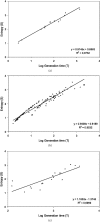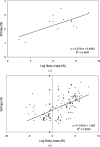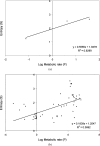Evolutionary entropy: a predictor of body size, metabolic rate and maximal life span
- PMID: 19172360
- PMCID: PMC2784518
- DOI: 10.1007/s11538-008-9382-6
Evolutionary entropy: a predictor of body size, metabolic rate and maximal life span
Abstract
Body size of organisms spans 24 orders of magnitude, and metabolic rate and life span present comparable differences across species. This article shows that this variation can be explained in terms of evolutionary entropy, a statistical parameter which characterizes the robustness of a population, and describes the uncertainty in the age of the mother of a randomly chosen newborn. We show that entropy also has a macroscopic description: It is linearly related to the logarithm of the variables body size, metabolic rate, and life span. Furthermore, entropy characterizes Darwinian fitness, the efficiency with which a population acquires and converts resources into viable offspring. Accordingly, entropy predicts the outcome of natural selection in populations subject to different classes of ecological constraints. This predictive property, when integrated with the macroscopic representation of entropy, is the basis for enormous differences in morphometric and life-history parameters across species.
Figures





Similar articles
-
Darwinian fitness.Theor Popul Biol. 2007 Nov;72(3):323-45. doi: 10.1016/j.tpb.2007.05.004. Epub 2007 Jul 5. Theor Popul Biol. 2007. PMID: 17804030 Review.
-
Directionality theory and mortality patterns across the primate lineage.Biogerontology. 2024 Nov;25(6):1215-1237. doi: 10.1007/s10522-024-10134-6. Epub 2024 Sep 6. Biogerontology. 2024. PMID: 39240404 Free PMC article.
-
Darwinian fitness and the intensity of natural selection: studies in sensitivity analysis.J Theor Biol. 2007 Dec 21;249(4):641-53. doi: 10.1016/j.jtbi.2007.08.016. Epub 2007 Aug 28. J Theor Biol. 2007. PMID: 17936306
-
Directionality theory and the evolution of body size.Proc Biol Sci. 2000 Dec 7;267(1460):2385-91. doi: 10.1098/rspb.2000.1295. Proc Biol Sci. 2000. PMID: 11133027 Free PMC article.
-
The units of selection and measures of fitness.Proc R Soc Lond B Biol Sci. 1985 Aug 22;225(1239):147-59. doi: 10.1098/rspb.1985.0056. Proc R Soc Lond B Biol Sci. 1985. PMID: 2864693 Review.
Cited by
-
Implications of quantum metabolism and natural selection for the origin of cancer cells and tumor progression.AIP Adv. 2012 Mar;2(1):11101. doi: 10.1063/1.3697850. Epub 2012 Mar 19. AIP Adv. 2012. PMID: 22489276 Free PMC article.
-
Natural Selection and Scale Invariance.Life (Basel). 2023 Mar 31;13(4):917. doi: 10.3390/life13040917. Life (Basel). 2023. PMID: 37109446 Free PMC article.
-
The evolution of ageing: classic theories and emerging ideas.Biogerontology. 2024 Oct 29;26(1):6. doi: 10.1007/s10522-024-10143-5. Biogerontology. 2024. PMID: 39470884 Free PMC article. Review.
-
Evolutionary entropy determines invasion success in emergent epidemics.PLoS One. 2010 Sep 23;5(9):e12951. doi: 10.1371/journal.pone.0012951. PLoS One. 2010. PMID: 20886082 Free PMC article.
-
The inverse association of cancer and Alzheimer's: a bioenergetic mechanism.J R Soc Interface. 2013 Feb 20;10(82):20130006. doi: 10.1098/rsif.2013.0006. Print 2013 May 6. J R Soc Interface. 2013. PMID: 23427097 Free PMC article.
References
-
- Baniameri V., Soleiman-Nejadian E., Mohaghegh J. Life table and age dependent reproduction of the predatory bug. Orius niger Wolff (Heteroptera: Antochoridae) at three constant temperatures: a demographic analysis. Appl. Entomol. Zool. 2005;40:545–550. doi: 10.1303/aez.2005.545. - DOI
-
- Bergmann C. Über die Verhaltnisse der Wärmekönomie die Tiere zu ihrer Grösse. Gött. Stud. 1847;1:595–708.
-
- Bonner J.T. The Evolution of Complexity. Princeton: Princeton University Press; 1988.
-
- Calder W.A. Size, Function and Life History. Cambridge: Harvard University Press; 1984.
MeSH terms
LinkOut - more resources
Full Text Sources

